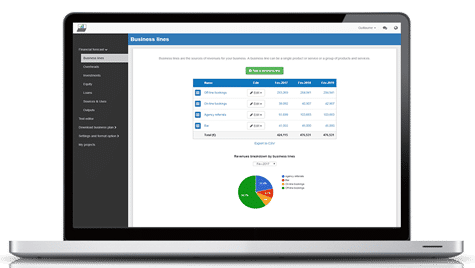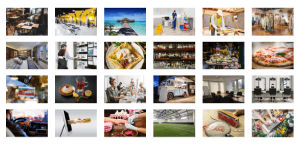How to create a financial forecast for a painting company?
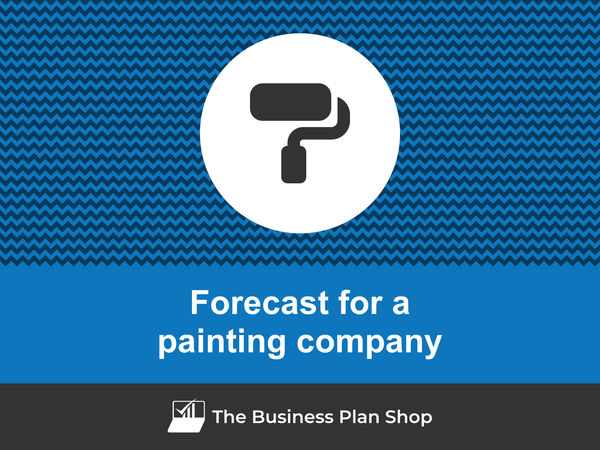
Creating a financial forecast for your painting company, and ensuring it stays up to date, is the only way to maintain visibility on future cash flows.
This might sound complex, but with the right guidance and tools, creating an accurate financial forecast for your painting company is not that hard.
In this guide, we'll cover everything from the main goal of a financial projection, the data you need as input, to the tables that compose it, and the tools that can help you build a forecast efficiently.
Without further ado, let us begin!
Why create and maintain a financial forecast for a painting company?
The financial projections for your painting company act as a financial blueprint to guide its growth with confidence and ensure its long-term financial viability.
To create them, you will need to look at your business in detail - from sales to operating costs and investments - to assess how much profit it can generate in the years to come and what will be the associated cash flows.
During challenging market conditions, maintaining an up-to-date financial forecast enables early detection of potential financial shortfalls, allowing for timely adjustments or securing financing before facing a cash crisis.
Your painting company's financial forecast will also prove invaluable when seeking financing. Banks and investors will undoubtedly request a thorough examination of your financial figures, making precision and presentation essential.
Need a solid financial forecast?
The Business Plan Shop does the maths for you. Simply enter your revenues, costs and investments. Click save and our online tool builds a three-way forecast for you instantly.
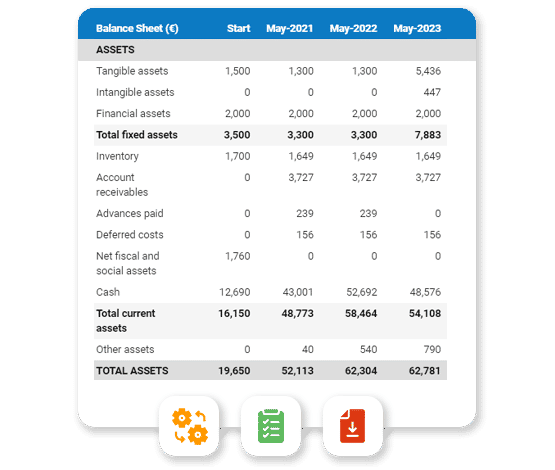
What information is used as input to build a painting company financial forecast?
A painting company's financial forecast needs to be built on the right foundation: your assumptions.
The data required to create your assumptions will depend on whether you are a new or existing painting company.
If you are creating (or updating) the forecast of an existing painting company, then your main inputs will be historical accounting data and operating metrics, and your team’s view on what to expect for the next three to five years.
If you are building financial projections for a new painting company startup, you will need to rely on market research to form your go-to-market strategy and derive your sales forecast.
For a new venture, you will also need an itemised list of resources needed for the painting company to operate, along with a list of equipment required to launch the venture (more on that below).
Now that you understand what is needed, let’s have a look at what elements will make up your painting company's financial forecast.
The sales forecast for a painting company
From experience, it usually makes sense to start your painting company's financial projection with the revenues forecast.
The inputs used to forecast your sales will include the historical trading data of your painting company (which can be used as a starting point for existing businesses) and the data collected in your market research (which both new ventures and existing businesses need to project their sales forward).
Your painting company's sales forecast can be broken down into two key estimates:
- The average price
- The number of monthly transactions
To assess these variables accurately, you will need to consider the following factors:
- Geographical location: The location of your painting company can greatly affect your average price and number of monthly transactions. If you are located in a high-income area, you may be able to charge higher prices for your services and attract more affluent customers. On the other hand, if you are located in a lower-income area, you may need to offer more competitive prices to attract customers and maintain a steady stream of monthly transactions.
- Seasonal demand: The time of year can also impact your average price and monthly transactions. In the summer, when many homeowners are looking to improve the exterior of their homes, you may see an increase in demand for your services. This could allow you to charge higher prices and complete more transactions. However, in the winter months, when the weather is not conducive to painting, you may see a decrease in demand and need to adjust your prices accordingly to maintain a steady flow of transactions.
- Types of services offered: The type of painting services you offer can also affect your average price and monthly transactions. For example, if you specialize in high-end, custom interior painting, you may be able to charge premium prices and attract a smaller but more affluent customer base. On the other hand, if you offer a variety of services, such as exterior painting, wallpaper removal, and drywall repair, you may attract a larger customer base but need to adjust your prices to remain competitive.
- Quality of work: The quality of your work can have a significant impact on your average price and monthly transactions. If you consistently deliver high-quality work and have satisfied customers, you may be able to charge higher prices and attract more referrals. On the other hand, if you have a reputation for subpar work, you may struggle to maintain a consistent flow of transactions and may need to lower your prices to attract customers.
- Economic conditions: Economic factors such as inflation, interest rates, and consumer confidence can also affect your average price and monthly transactions. During times of economic downturn, homeowners may be more cautious with their spending and may be less likely to invest in painting services, leading to a decrease in transactions and a need to adjust prices. Conversely, during times of economic growth, you may see an increase in demand for your services and may be able to charge higher prices.
Once you have a sales forecast in place, the next step will be to work on your overhead budget. Let’s have a look at that now.
Need inspiration for your business plan?
The Business Plan Shop has dozens of business plan templates that you can use to get a clear idea of what a complete business plan looks like.
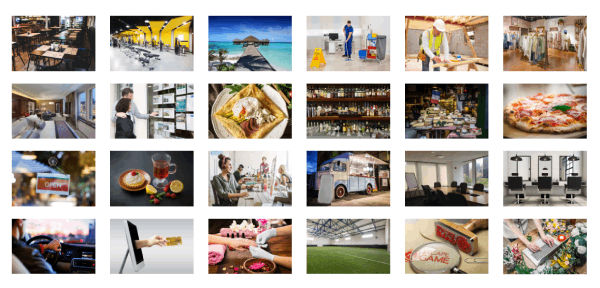
The operating expenses for a painting company
The next step is to estimate the expenses needed to run your painting company on a day-to-day basis.
These will vary based on the level of sales expected, and the location and size of your business.
But your painting company's operating expenses should include the following items at a minimum:
- Staff costs: This includes the salaries, wages, and benefits of your painters, as well as any administrative staff you may have.
- Accountancy fees: You will need to hire an accountant to help you with bookkeeping, tax preparation, and other financial tasks.
- Insurance costs: As a painting company, you will need to have liability insurance to protect your business from any accidents or damages.
- Software licenses: You may need to invest in software for project management, accounting, or design purposes.
- Banking fees: This includes any charges for using business bank accounts, credit cards, or other financial services.
- Marketing and advertising costs: You will need to promote your painting company through various channels such as online ads, flyers, or local publications.
- Materials and supplies: This includes the cost of paint, brushes, drop cloths, and other necessary supplies for painting jobs.
- Vehicle expenses: If you have company vehicles for transporting equipment and materials, you will need to budget for gas, maintenance, and insurance costs.
- Rent or mortgage payments: If you have a physical office or workspace, you will need to factor in the cost of rent or mortgage payments.
- Utilities: This includes electricity, water, and other necessary utilities for running your business.
- Training and development: You may need to invest in training programs or workshops for your staff to improve their skills and stay updated with industry trends.
- Legal fees: You may need to consult with a lawyer for contracts, permits, or other legal matters related to your painting business.
- Office supplies: This includes items such as paper, printer ink, and other office supplies needed for day-to-day operations.
- Travel expenses: If you have to travel for business purposes, you will need to budget for transportation, lodging, and meals.
- Miscellaneous expenses: This includes any other unforeseen expenses that may arise, such as repairs or maintenance costs.
This list is, of course, not exhaustive, and you'll have to adapt it according to your precise business model and size. A small painting company might not have the same level of expenditure as a larger one, for example.
What investments are needed to start or grow a painting company?
Once you have an idea of how much sales you could achieve and what it will cost to run your painting company, it is time to look into the equipment required to launch or expand the activity.
For a painting company, capital expenditures and initial working capital items could include:
- Painting Equipment: This includes items such as paint sprayers, ladders, scaffolding, and other tools necessary for painting services. These are essential fixed assets for a painting company and should be included in your expenditure forecast.
- Vehicles: Depending on the size of your painting company, you may need to purchase or lease vehicles for transportation of equipment and supplies to job sites. These can include vans, trucks, or trailers and should be considered as a capital expenditure.
- Office Furniture and Equipment: This can include items such as desks, chairs, computers, and printers for your office space. While not directly related to painting services, these are necessary fixed assets for running your business and should be included in your expenditure forecast.
- Building Renovations: If you own your office space or plan to purchase a building for your painting company, any renovations or improvements to the property should be included in your capital expenditure forecast. This can include items such as painting, flooring, or electrical work.
- Safety Equipment: As a painting company, it is important to invest in safety equipment such as respirators, safety glasses, and protective clothing for your employees. These items should be considered as a fixed asset and included in your expenditure forecast.
Again, this list will need to be adjusted according to the specificities of your painting company.
Need a convincing business plan?
The Business Plan Shop makes it easy to create a financial forecast to assess the potential profitability of your projects, and write a business plan that’ll wow investors.
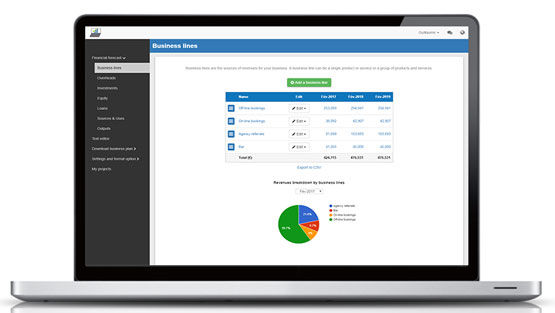
The financing plan of your painting company
The next step in the creation of your financial forecast for your painting company is to think about how you might finance your business.
You will have to assess how much capital will come from shareholders (equity) and how much can be secured through banks.
Bank loans will have to be modelled so that you can separate the interest expenses from the repayments of principal, and include all this data in your forecast.
Issuing share capital and obtaining a bank loan are two of the most common ways that entrepreneurs finance their businesses.
What tables compose the financial plan for a painting company?
Now let's have a look at the main output tables of your painting company's financial forecast.
The projected profit & loss statement
The projected profit & loss shows how profitable your painting company is likely to be in the years to come.
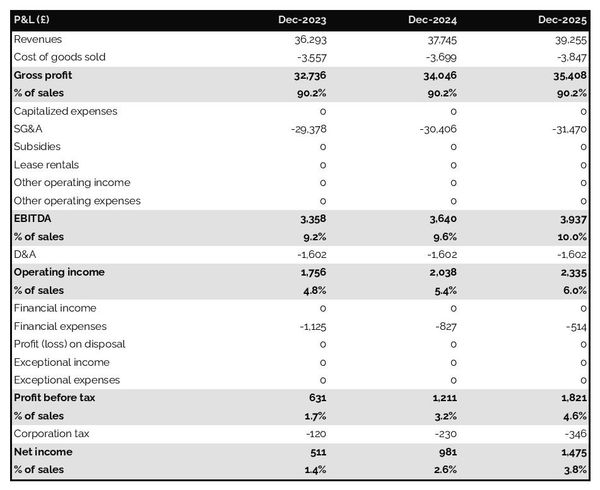
For your painting company to be financially viable, your projected P&L should ideally show:
- Sales growing above inflation (the higher the better)
- Profit margins which are stable or expanding (the higher the better)
- A net profit at the end of each financial year (the higher the better)
This is for established painting companies, there is some leniency for startups which will have numbers that will look a bit different than existing businesses.
The projected balance sheet
Your painting company's forecasted balance sheet enables you to assess your financial structure and working capital requirements.
It is composed of three types of elements: assets, liabilities and equity:
- Assets: represent what the business owns and uses to produce cash flows. It includes resources such as cash, equipment, and accounts receivable (money owed by clients).
- Liabilities: represent funds advanced to the business by lenders and other creditors. It includes items such as accounts payable (money owed to suppliers), taxes due and loans.
- Equity: is the combination of what has been invested by the business owners and the cumulative profits and losses generated by the business to date (which are called retained earnings). Equity is a proxy for the value of the owner's stake in the business.
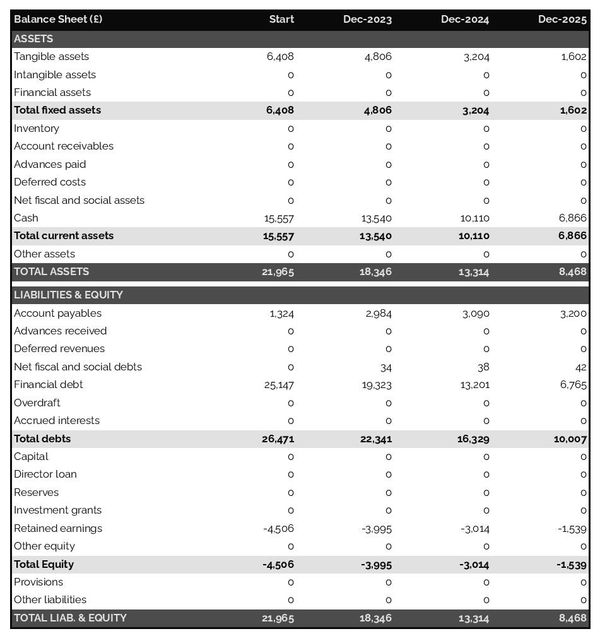
The cash flow projection
The cash flow forecast of your painting company will show how much cash the business is expected to generate or consume over the next three to five years.
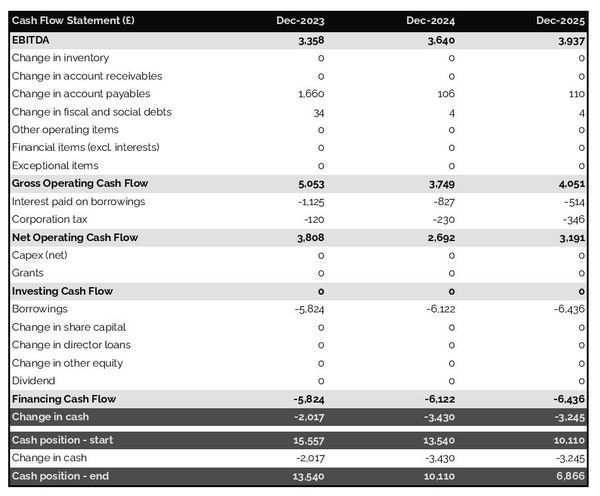
There are multiple ways of presenting a cash flow forecast but from experience, it is better to organise it by nature in order to clearly show these elements:
- Operating cash flow: how much cash is generated by the painting company's operations
- Investing cash flow: what is the business investing to expand or maintain its equipment
- Financing cash flow: is the business raising additional funds or repaying financiers (debt repayment, dividends)
Your cash flow forecast is the most important element of your overall financial projection and that’s where you should focus your attention to ensure that your painting company is adequately funded.
Note: if you are preparing a financial forecast in order to try to secure funding, you will need to include both a yearly and monthly cash flow forecast in your painting company's financial plan.
Need a solid financial forecast?
The Business Plan Shop does the maths for you. Simply enter your revenues, costs and investments. Click save and our online tool builds a three-way forecast for you instantly.

Which tool should you use to create your painting company's financial forecast?
Creating your painting company's financial forecast may sound fairly daunting, but the good news is that there are several ways to go about it.
Using online financial forecasting software to build your painting company's projections
The modern and easiest way is to use an online financial forecasting tool such as the one we offer at The Business Plan Shop.
There are several advantages to using specialised software:
- You can easily create your financial forecast by letting the software take care of the financial calculations for you without errors
- You have access to complete financial forecast templates
- You get a complete financial forecast ready to be sent to your bank or investors
- You can easily track your actual financial performance against your financial forecast, and recalibrate your forecast as the year goes by
- You can create scenarios to stress test your forecast's main assumptions
- You can easily update your forecast as time goes by to maintain visibility on future cash flows
- You have a friendly support team on standby to assist you when you are stuck
- It’s cost-efficient and much cheaper than using an accountant or consultant (see below)
If you are interested in this type of solution, you can try our projection software for free by signing up here.
Calling in a financial consultant or chartered accountant
Enlisting the help of a consultant or accountant is also a good way to obtain a professional painting company financial forecast.
The downside of this solution is its cost. From experience, obtaining a simple financial forecast over three years (including a balance sheet, income statement, and cash flow statement) is likely to cost a minimum of £700 or $1,000.
The indicative cost above, is for a small business, and a forecast is done as a one-shot exercise. Using a consultant or accountant to track your actuals vs. forecast and to keep your financial projections up to date on a monthly or quarterly basis will cost a lot more.
If you opt for this solution, make sure your accountant has in-depth knowledge of your industry, so that they may challenge your figures and offer insights (as opposed to just taking your assumptions at face value to create the forecast).
Why not use a spreadsheet such as Excel or Google Sheets to build your painting company's financial forecast?
You and your financial partners need numbers you can trust. Unless you have studied finance or accounting, creating a trustworthy and error-free painting company financial forecast on a spreadsheet is likely to prove challenging.
Financial modelling is very technical by nature and requires a solid grasp of accounting principles to be done without errors. This means that using spreadsheet software like Excel or Google Sheets to create accurate financial forecasts is out of reach for most business owners.
Creating forecasts in Excel is also inefficient nowadays:
- Software has advanced to the point where forecasting can be done much faster and more accurately than manually on a spreadsheet.
- With artificial intelligence, the software is capable of detecting mistakes and helping decision-making.
Spreadsheets are versatile tools but they are not tailor-made for reporting. Importing your painting company's accounting data in Excel to track actual vs. forecast is incredibly manual and tedious (and so is keeping forecasts up to date). It is much faster to use dedicated financial planning tools like The Business Plan Shop which are built specially for this.
Need a convincing business plan?
The Business Plan Shop makes it easy to create a financial forecast to assess the potential profitability of your projects, and write a business plan that’ll wow investors.

Use our financial projection templates for inspiration
The Business Plan Shop has dozens of financial forecasting templates available.
Our examples contain both the financial forecast, and a written business plan which presents, in detail, the company, the team, the strategy, and the medium-term objectives.
Whether you are just starting out or already have your own painting company, looking at our template is always a good way to get ideas on how to model financial items and what to write when creating a business plan to secure funding.

Takeaways
- Having a financial forecast enables you to visualise the expected growth, profitability, and cash generation for your business over the next three to five years.
- Tracking actuals vs. forecast and keeping your financial projections up-to-date is the only way to get a view on what your painting company future cash flows may look like.
- Using financial forecasting software is the mordern and easy way to create and maintain your forecasts.
This is the end of our guide on how to build the financial forecast for a painting company, we hope you found it useful. Don't hesitate to contact us if you want to share your feedback or have any questions.
Need inspiration for your business plan?
The Business Plan Shop has dozens of business plan templates that you can use to get a clear idea of what a complete business plan looks like.

Also on The Business Plan Shop
Know someone who owns or is thinking of starting a painting company? Share our forecasting guide with them!

